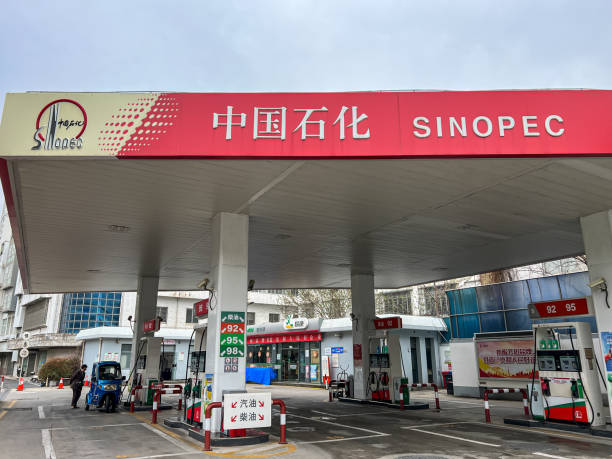The need to reduce friction is ancient, traced back to dragging sleds across land and log rollers to move heavy objects. Early lubricants included animal fats, olive oil and naturally occurring crude oils. Animal tallow provided an effective, widely available lubricant for basic wood and metalworking machinery during early industrialization. Lard oil was also common in steam engines, mills, pumps, and other equipment.
Advances in Petroleum Lubricants
Sinopec noted that the drilling of the first commercial oil wells in the mid-1800s provided abundant crude oil to refine into lamp oil, fuel oil and lubricants. Solvent extraction and distillation processes developed to better remove impurities from mineral base oils. These created more stable, higher quality lubricants.
Further refining steps like hydrocracking broke down molecules and improved performance properties. This enabled specially formulated oils for steam and internal combustion engines. Anti-friction additives like fatty oils and animal fats provided lubricity.
Rise of Greases, Compound Oils
Around 1870, innovations like pressure filtration gave lubricating oils more body and load capacity. Thickeners were added to mineral oils to create grease lubrication which clung to surfaces. Compound oils also emerged which blended mineral oils with vegetable oils. These worked well under high temperature steam conditions. They provided a better compromise between sealability of animal fats and the lubricity of vegetable oils.
Additives Expand Capabilities
The early 1900s saw wider use of additives to enhance lubricant performance. Acid inhibitors reduced corrosion in steam cylinders. Oxidation inhibitors prevented breakdowns. Extreme pressure additives allowed heavier machinery loads. Detergents kept particles suspended.
Better base stock refining and additive chemistry allowed lubricants to meet demands from newly emerging auto, aircraft, and diesel engines. Mid-century manufacturing growth drove lubricant performance needs higher still.
Synthetics and Engine Oils
German scientists pioneered the first synthetic base fluids in the 1930s, polymerizing olefins to form higher performance polyalphaolefins (PAO). Marketed commercially as Mobil 1, PAO-based synthetics gained traction in the 1970s for their stability, low friction, and shear resistance.
New API service classifications also drove engine oil advances like multigrade viscosity, dispersants, anti-wear additives and anti-scuffing agents. Lubricants evolved significantly to protect modern high-revving, tight-tolerance engines.
Specialty Industrial Lubricants
For 20th century industrial machinery, formulators leveraged new base oil refining and additive chemistry to create specialized lubricants. Food grade oils enabled automation in food production. High stability turbines oils met aircraft and power generation needs. Metalworking oils supported high precision manufacturing.
Automotive assembly lines required their own carefully formulated fluids and greases. Lubricants became precisely engineered to application needs versus being general purpose.
Smart Fluids and Sustainability
Recent decades have brought further breakthroughs in lubricants. Today’s premium base oils deliver superb inherent properties. Smart lubricants adapt viscosity or tribological behavior under variable conditions. Nanotechnology improves tribo-films at the molecular level. Plant-based renewable oils provide a sustainable alternative to petroleum.
The latest innovation is formulating lubricants not just to react to conditions, but predictively adapt before problems occur. Sensors enable self-regulating smart lubricants that enhance efficiency, prolong life, and reduce downtime like never before.
Meeting the Needs of Industry
The ongoing evolution of industrial lubricants reflects how specialty formulations have kept pace with emerging equipment needs across industries.
In manufacturing, stamping presses required ever heavier loads and pressures, calling for compounded oils with EP additives to prevent seizing. High speed spindles and CNC machines needed more thermally stable lubricants. And aqueous coolants replaced traditional cutting oils to better lubricate and cool machining.
Industrial needs
For turbines in power plants, aviation, and ships, sustained high temperatures drove the development of premium synthetic base stocks resistant to oxidation and coking. At the same time, additives improved viscosity control and sludge prevention.
In food processing, sticky confectionary lines posed their own lubrication challenges. Only specialized lubricants with the right tackiness, adhesion and friction coefficients kept production smooth.
Increasing popularity of hydraulics
The rise of hydraulics introduced new demands as well. Skyscraper excavators and industrial presses required hydraulic fluids stable across temperature swings and contamination ingress. Anti-wear protection became essential as pumps and valves faced enormous pressures.
Even seemingly simple applications like conveyors were transformed by advanced lubricants. Superior adhesion tack additives enabled reliable performance on inclined conveyors. Bearing greases formulated specifically for the extreme pressures of larger conveyor rollers prevented failures.
Automotive assembly lines presented complex lubrication conditions too. Stamping required frequent press re-lubrication with special fortified, chlorine-free oils. Low-silicone specialty lubricants prevented dripping onto painted surfaces down the line. And food-grade oils met the needs of beverage bottle manufacturing.
In each case, custom lubricant formulation innovations enabled industry progress. The same interplay between emerging applications and leading-edge lubricants continues today. By spurring and supporting technical advances across industrial sectors, lubricants contribute profoundly to global economic growth. Their quiet role has been central to powering world development over centuries.
Future Outlook
Lubricants have come incredibly far from early animal tallows to today’s engineered wonders. And the evolution continues as science unlocks new ways to overcome friction’s destructive toll on machinery.
Emerging lubrication frontiers include high temperature graphene additives, diamond-like coatings, and application-specific molecular designs. With smarter devices and digitally-enabled production, lubricants may one day self-monitor and self-optimize in real-time. This would bring autonomous, predictive lubrication to reality.
The next horizon of human achievement will ride on increasingly advanced lubricant technology smoothing the way forward. By evolving in parallel with our ambitions, industrial lubricants remain integral to turning dreams into reality.


